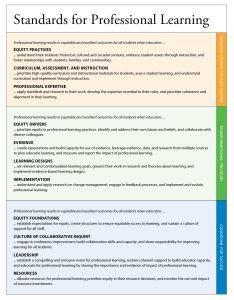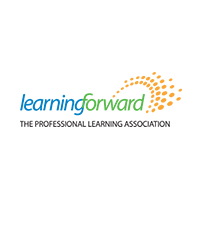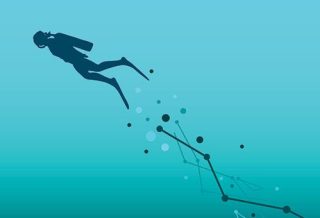TOOLS
Achieving the full benefit of new curriculum
By Learning Forward
Categories: Instructional materials/curriculum, Learning designs, Standards for Professional LearningJune 2023
To illustrate how Standards for Professional Learning can guide educators in navigating their challenges, Learning Forward created a set of fictional case vignettes that draw on real experiences. The vignettes show educators in varied roles and settings as they apply professional learning to problems of practice. The following narrative homes in on high-quality curriculum and the vital role of professional learning in building educators’ capacity to implement it. Prompts for reflection and discussion are included to assist with applying the lessons to other contexts and situations. This vignette can be used alone or in combination with the vignette published in the February 2023 issue of The Learning Professional, which focused on equity-centered leadership, or other vignettes available at standards.learningforward.org.
Suggestions for use
- Read the following vignette, using the prompts that follow to track notes, insights, and questions for subsequent conversations.
- Note or highlight where you see direct or indirect evidence of Standards for Professional Learning throughout the narrative. While themes from Culture of Collaborative Inquiry, Equity Practices, and Curriculum, Assessment, and Instruction standards are prominent, aspects of most standards are present to depict a systems approach to implementing high-quality professional learning.
- Use the notes and insights to inform a team discussion or individual reflection to lead to deeper understanding and shared actions.
Identifying the challenge
The science team at Eastside High School is focused on strengthening its capacity to use its new science curriculum over the next year. The science chair, David Morales, and the teachers on his team are concerned about the evidence that the school’s students aren’t consistently experiencing the quality of teaching they deserve or that the curriculum could yield.
A couple of years earlier, the district had identified sharp declines in enrollment in higher-level science classes, particularly among Black and Latinx students. Several recent graduates enrolled in demanding college courses acknowledged that they weren’t prepared for them. To address this challenge, the district adopted the Next Generation Science Standards (NGSS). District leaders followed up with the purchase of new NGSS-aligned high-quality curriculum and instructional materials. End-of-year surveys revealed that the teachers at Eastside High recognized that, after the initial training, district leaders had an expectation for immediate improved results for students without allocating sufficient time for teachers to shift instruction or practices aligned to the high-quality materials. NGSS-aligned teaching requires teachers to facilitate student experimentation and application more than providing direct instruction. This shift requires dedicated learning time for teachers to build skills, practices, and confidence levels.
While Morales is convinced that the new curriculum materials will help students make great gains in learning, he recognizes that his whole team needs meaningful and sustained professional learning to make the shifts in instruction the materials demand. His principal, Maria Fresno, agrees and serves as a thought partner and resource provider. Fresno is part of the district’s professional learning leadership network, which uses Standards for Professional Learning to guide the work they do districtwide. She brings the resulting knowledge and tools back to the school’s leadership team to inform how to transform professional learning. Members of the leadership team use specialized implementation tools (Innovation Configuration maps) to get on the same page in terms of language, goals for improvement, and specific actions to take.
Collective and individual learning needs
As Morales brings ideas and plans to the science team, he engages his colleagues in ongoing conversation about their best next actions. He stresses that knowing and using the new curriculum well is the top priority if their goal is to ensure each student has access to rigorous, grade-level learning. The educators agree to study the whole curriculum as well as their upcoming units in depth in teams, both to build their knowledge and skills and to map out their learning goals for the short and long term. Morales also helps the team recognize that its collaborative study of materials will ultimately save time as the team collectively deepens its expertise and builds a toolbox of strategies and lessons.
Among the teachers, the experience levels vary widely, with one team member fresh out of college and Morales with more than 25 years of experience. Their learning needs are diverse.
While studying the instructional materials, Clara Ortiz-Westin, the team’s newest teacher, recognizes her need to go back to the Next Generation Science Standards to bolster her understanding of several key concepts in the physical sciences. Her teammate, Jayne Evans, invites Ortiz-Weston to her class for an upcoming lesson that Evans believes demonstrates strategies for addressing misconceptions. Fran Maddox, also a long-time educator, commits to contacting the science chair at Long High School, another school in the district that has seen success with the same instructional materials. Based on her conversation with the science chair at Long, Maddox offers suggestions about designing the science team’s learning in ways that mirror the learning the students will do as they use the materials. For example, in teams, the teachers study specific lessons and talk about scientific phenomena in the ways they will facilitate students to do. Principal Fresno, who occasionally participates in the team meetings, underscores the importance of every educator experiencing the curriculum as a student would.
Establishing a rhythm for improvement
As a team, the teachers agree they find great value in unpacking the content of their instructional materials in collaboration and identifying instructional strategies that meet the varied needs of their students. Morales reminds the team that the student learning goals represented throughout the standards and curriculum are the team’s guideposts. In his own study of Standards for Professional Learning, he recognizes that educators set their learning goals based on student needs. Monitoring progress toward shared learning goals must be part of their work.
Six months later, the science faculty has made significant progress by establishing a rhythm of unit-specific team meetings, where teachers identify their learning needs and an agenda to meet them. Not only does each teacher have a more thorough understanding of the instructional materials, but teachers have also developed, practiced, and modified a range of supplementary adaptations for the students who struggled to achieve grade-level mastery or for those who demonstrated mastery early on and benefited from extended learning options. Principal Fresno enlisted a district science subject specialist coach to join learning teams periodically to help examine data and suggest next steps for study. The coach also joins teachers in their classrooms to observe and debrief lessons.
The team meetings vary depending on what the educators need. They typically start with an analysis of evidence about student progress, including student work artifacts, quiz answers, or unit tests. As a team, the teachers make meaning from the data and discuss implications to help revise the unit, including assessments, continually seeking tight alignment between curriculum, assessment, and instruction. During some conversations, a teacher conducts a brief minilesson to showcase an instructional practice and answer questions. Other times, the teachers watch a video together of a model lesson or discuss a supplemental resource they’ve agreed to study to strengthen their own subject expertise. They always end by committing to their next agenda.

Looking ahead
As the year ends, Morales is pleased to see improvement overall, with evidence in every class of advances in student learning on teacher-developed assessments. He knows that in the following year, the team will commit more of its time to learning to use the curriculum.
Morales successfully advocates for an extension of team meeting time with the principal and also makes the case with the curriculum coordinator that a member of his team will serve on the district’s instructional materials committee to inform the district’s professional learning and implementation practices.
Download pdf here.
Prompts for discussion and reflection:
- What critical school and district challenges are present?
- What strengths and improvement-oriented actions do you see in the vignette? Where do you see room for growth?
- Which Standards for Professional Learning do you see reflected? Note key phrases that represent the standards at work.
- What ideas, questions, or concerns does the vignette spark for your work in your context?

Learning Forward is the only professional association devoted exclusively to those who work in educator professional development. We help our members plan, implement, and measure high-quality professional learning so they can achieve success with their systems, schools, and students.
Categories: Instructional materials/curriculum, Learning designs, Standards for Professional Learning
Recent Issues
EVALUATING PROFESSIONAL LEARNING
February 2024
How do you know your professional learning is working? This issue digs...
TAKING THE NEXT STEP
December 2023
Professional learning can open up new roles and challenges and help...
REACHING ALL LEARNERS
October 2023
Both special education and general education teachers need support to help...
THE TIME DILEMMA
August 2023
Prioritizing professional learning time is an investment in educators and...











